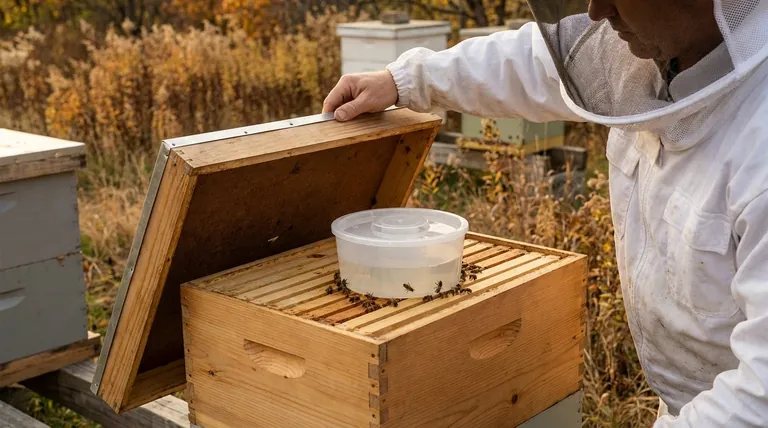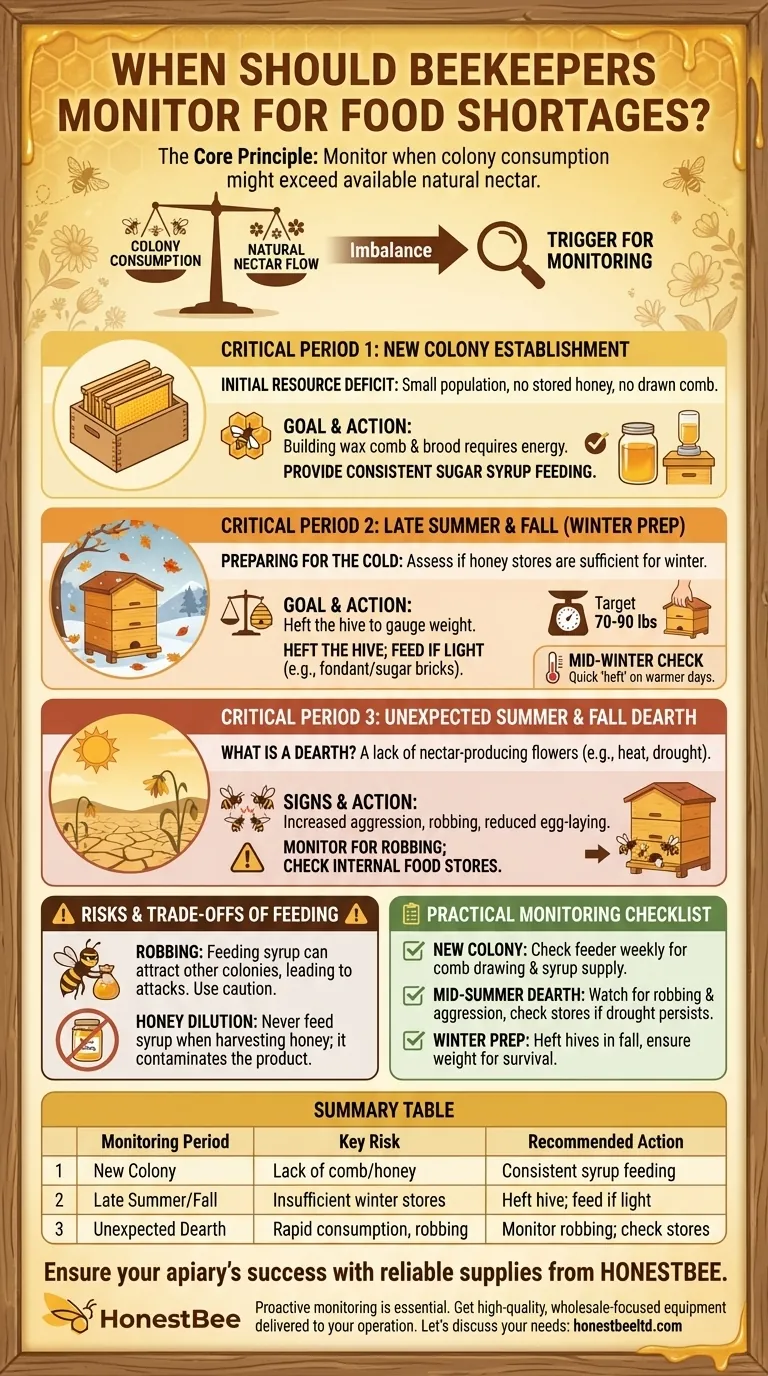The short answer is this: Beekeepers must monitor for food shortages during any period when the colony's consumption might exceed the available natural nectar. This monitoring is most critical when establishing a new colony, during the late summer or fall in preparation for winter, and during unexpected nectar "dearths" or droughts.
The core principle is not to feed bees constantly, but to monitor them proactively during high-risk periods. A healthy, established colony is remarkably self-sufficient, and your role is to intervene only when natural resources are insufficient to meet their needs for survival and growth.

The Principle: Balancing Colony Needs with Natural Forage
Why Bees Are Usually Self-Sufficient
Honey bee colonies are masters of resource management. Foraging bees collect nectar and pollen from flowering plants, which they use to feed the queen, larvae (brood), and the rest of the colony, storing the excess as honey for future use.
During a healthy nectar flow—a period when many plants are blooming—a strong colony can easily gather more food than it consumes.
When the Balance Tips
Problems arise when this natural income of resources stops or slows, but the colony's consumption continues. This imbalance is the trigger for potential starvation and requires careful monitoring.
Critical Monitoring Period 1: New Colony Establishment
The Initial Resource Deficit
A new package of bees or a nucleus hive (nuc) starts with a significant disadvantage. They have a small population, no stored honey, and no drawn-out comb for the queen to lay eggs or for workers to store resources.
The Goal: Building Comb and Brood
The colony's first priority is to build wax comb. This is an energy-intensive process that requires a massive and consistent supply of carbohydrates (nectar or sugar syrup).
Without supplemental feeding, a new colony may struggle to build up its population and resources before the first winter, making this a critical period to monitor and support them.
Critical Monitoring Period 2: The Winter Months
Preparing for the Cold
The most important winter monitoring happens in the late summer and fall. Your goal is to assess if the bees have stored enough honey to survive the long, cold months when they cannot forage.
A common method is to lift the back of the hive to gauge its weight. A heavy hive indicates ample honey stores, while a light hive is a major red flag that they may starve before spring.
Mid-Winter Checks
While a full hive inspection in the cold is dangerous, a quick "heft" of the hive on a warmer winter day can tell you if they are burning through their stores too quickly. This check can inform the need for emergency winter feeding, such as with fondant or sugar bricks.
The Overlooked Danger: Summer and Fall Dearth
What is a Dearth?
A dearth is a period when there is a lack of nectar-producing flowers. This can happen unexpectedly, even in the middle of summer, due to high heat, drought, or a gap between major blooms.
Signs of a Dearth
During a dearth, a strong colony can quickly consume its honey reserves. Signs include increased aggression, bees robbing honey from weaker hives, and a reduction in the queen's egg-laying.
Monitoring hive activity at the entrance is crucial. If you see fighting or notice a sharp drop in bees returning with pollen, it’s a signal to check their internal food stores.
Understanding the Trade-offs of Feeding
The Risk of Robbing
Feeding liquid syrup, especially with open-style feeders, can attract bees from other colonies. This can incite robbing, where stronger hives attack and steal resources from weaker ones, often leading to the collapse of the robbed colony.
The Dilution of Honey Stores
Never feed sugar syrup when you intend to harvest honey. If bees store the syrup in the honey supers, it will contaminate the final product, which can no longer be legally or ethically sold as pure honey.
A Practical Monitoring Checklist
- If you have a new colony: Check their feeder and frames weekly to ensure they are consistently drawing comb and have a steady supply of syrup.
- If you are in mid-summer: Watch for signs of a dearth like robbing or unusual aggression, and check food stores if a drought persists.
- If you are preparing for winter: Heft your hives in the fall to ensure they weigh enough to survive; a typical target is 70-90 pounds for a standard Langstroth hive.
Proactive monitoring is the defining skill of a successful beekeeper.
Summary Table:
| Monitoring Period | Key Risk | Recommended Action |
|---|---|---|
| New Colony Establishment | Lack of drawn comb and stored honey | Provide consistent sugar syrup feeding |
| Late Summer / Fall (Winter Prep) | Insufficient honey stores for winter | Heft the hive; feed if light |
| Unexpected Summer/Fall Dearth | Rapid consumption of reserves during a nectar gap | Monitor for robbing; check internal stores |
Ensure your apiary's success with reliable supplies from HONESTBEE.
Proactive monitoring is essential, but having the right equipment makes all the difference. Whether you're a commercial apiary managing hundreds of hives or a distributor supplying fellow beekeepers, HONESTBEE provides the high-quality, wholesale-focused beekeeping supplies you need to support healthy colonies through every season.
Let's discuss your needs: Contact our team today to get durable feeders, hive components, and other essential equipment delivered efficiently to your operation.
Visual Guide

Related Products
- Rapid Bee Feeder White Plastic 2L Round Top Feeder for 8 or 10-Frame Bee Hives
- HONESTBEE Round Hive Top Bee Feeder for Syrup
- Classic Boardman Entrance Bee Feeder Hive Front Feeding Solution
- HONESTBEE Entrance Bee Feeder Professional Hive Nutrition Solution for Beekeeping
- Professional Hive Top Bee Feeder for Beekeeping
People Also Ask
- How much honey does a strong hive need to survive winter? Ensure Your Colony's Survival (60-80 lbs)
- Do beekeepers leave honey for bees? The Essential Guide to Sustainable Hive Management
- What are the recommended sugar-to-water ratios for making sugar syrup for bees? Optimize Your Hive's Health
- What is the capacity of the round hive top feeder for syrup and pollen? A Guide to Targeted Apiary Support
- What is the best thing to feed bees? A Guide to Supplemental Feeding for a Thriving Hive



















